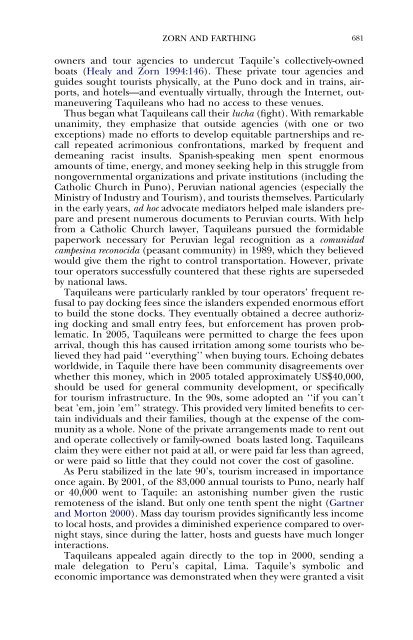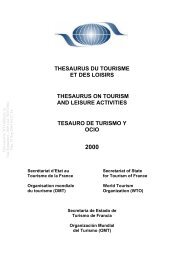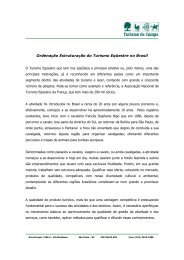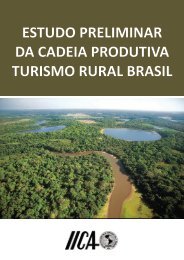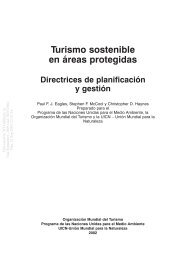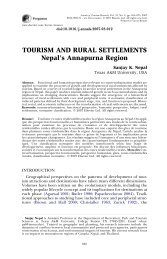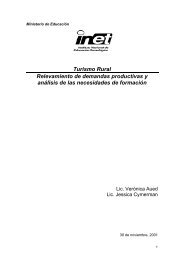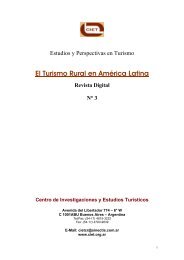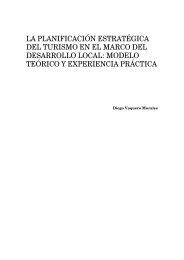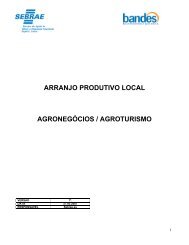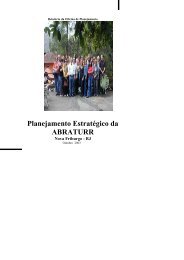COMMUNITARIAN TOURISM Hosts and Mediators in Peru
COMMUNITARIAN TOURISM Hosts and Mediators in Peru
COMMUNITARIAN TOURISM Hosts and Mediators in Peru
You also want an ePaper? Increase the reach of your titles
YUMPU automatically turns print PDFs into web optimized ePapers that Google loves.
ZORN AND FARTHING 681<br />
owners <strong>and</strong> tour agencies to undercut Taquile’s collectively-owned<br />
boats (Healy <strong>and</strong> Zorn 1994:146). These private tour agencies <strong>and</strong><br />
guides sought tourists physically, at the Puno dock <strong>and</strong> <strong>in</strong> tra<strong>in</strong>s, airports,<br />
<strong>and</strong> hotels—<strong>and</strong> eventually virtually, through the Internet, outmaneuver<strong>in</strong>g<br />
Taquileans who had no access to these venues.<br />
Thus began what Taquileans call their lucha (fight). With remarkable<br />
unanimity, they emphasize that outside agencies (with one or two<br />
exceptions) made no efforts to develop equitable partnerships <strong>and</strong> recall<br />
repeated acrimonious confrontations, marked by frequent <strong>and</strong><br />
demean<strong>in</strong>g racist <strong>in</strong>sults. Spanish-speak<strong>in</strong>g men spent enormous<br />
amounts of time, energy, <strong>and</strong> money seek<strong>in</strong>g help <strong>in</strong> this struggle from<br />
nongovernmental organizations <strong>and</strong> private <strong>in</strong>stitutions (<strong>in</strong>clud<strong>in</strong>g the<br />
Catholic Church <strong>in</strong> Puno), <strong>Peru</strong>vian national agencies (especially the<br />
M<strong>in</strong>istry of Industry <strong>and</strong> Tourism), <strong>and</strong> tourists themselves. Particularly<br />
<strong>in</strong> the early years, ad hoc advocate mediators helped male isl<strong>and</strong>ers prepare<br />
<strong>and</strong> present numerous documents to <strong>Peru</strong>vian courts. With help<br />
from a Catholic Church lawyer, Taquileans pursued the formidable<br />
paperwork necessary for <strong>Peru</strong>vian legal recognition as a comunidad<br />
campes<strong>in</strong>a reconocida (peasant community) <strong>in</strong> 1989, which they believed<br />
would give them the right to control transportation. However, private<br />
tour operators successfully countered that these rights are superseded<br />
by national laws.<br />
Taquileans were particularly rankled by tour operators’ frequent refusal<br />
to pay dock<strong>in</strong>g fees s<strong>in</strong>ce the isl<strong>and</strong>ers expended enormous effort<br />
to build the stone docks. They eventually obta<strong>in</strong>ed a decree authoriz<strong>in</strong>g<br />
dock<strong>in</strong>g <strong>and</strong> small entry fees, but enforcement has proven problematic.<br />
In 2005, Taquileans were permitted to charge the fees upon<br />
arrival, though this has caused irritation among some tourists who believed<br />
they had paid ‘‘everyth<strong>in</strong>g’’ when buy<strong>in</strong>g tours. Echo<strong>in</strong>g debates<br />
worldwide, <strong>in</strong> Taquile there have been community disagreements over<br />
whether this money, which <strong>in</strong> 2005 totaled approximately US$40,000,<br />
should be used for general community development, or specifically<br />
for tourism <strong>in</strong>frastructure. In the 90s, some adopted an ‘‘if you can’t<br />
beat ’em, jo<strong>in</strong> ’em’’ strategy. This provided very limited benefits to certa<strong>in</strong><br />
<strong>in</strong>dividuals <strong>and</strong> their families, though at the expense of the community<br />
as a whole. None of the private arrangements made to rent out<br />
<strong>and</strong> operate collectively or family-owned boats lasted long. Taquileans<br />
claim they were either not paid at all, or were paid far less than agreed,<br />
or were paid so little that they could not cover the cost of gasol<strong>in</strong>e.<br />
As <strong>Peru</strong> stabilized <strong>in</strong> the late 90’s, tourism <strong>in</strong>creased <strong>in</strong> importance<br />
once aga<strong>in</strong>. By 2001, of the 83,000 annual tourists to Puno, nearly half<br />
or 40,000 went to Taquile: an astonish<strong>in</strong>g number given the rustic<br />
remoteness of the isl<strong>and</strong>. But only one tenth spent the night (Gartner<br />
<strong>and</strong> Morton 2000). Mass day tourism provides significantly less <strong>in</strong>come<br />
to local hosts, <strong>and</strong> provides a dim<strong>in</strong>ished experience compared to overnight<br />
stays, s<strong>in</strong>ce dur<strong>in</strong>g the latter, hosts <strong>and</strong> guests have much longer<br />
<strong>in</strong>teractions.<br />
Taquileans appealed aga<strong>in</strong> directly to the top <strong>in</strong> 2000, send<strong>in</strong>g a<br />
male delegation to <strong>Peru</strong>’s capital, Lima. Taquile’s symbolic <strong>and</strong><br />
economic importance was demonstrated when they were granted a visit


